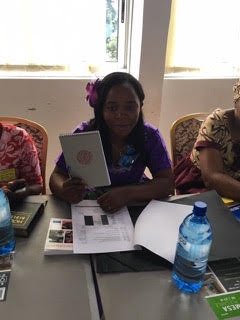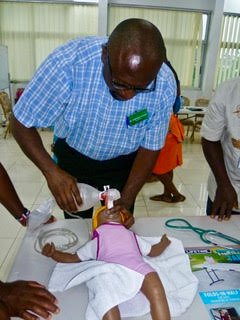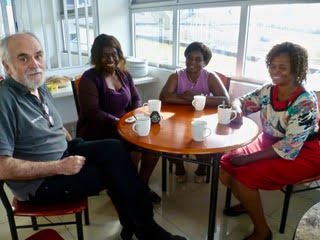







We are fortunate that NICHE has friends who support us in various ways.
This is Gloria, approaching her 10th decade, and an inveterate knitter!

One of WHO’s main recommendations for newborn care is prevention of hypothermia. Newborn babies quickly lose heat through their heads; drying and covering the head with a hat immediately after birth is a simple but vital step. This is equally important in hot and cold countries.
When NICHE instructors train midwives and other birth attendants in a low resource country, we leave equipment for them to use. This includes a supply of hats for babies, as mothers do not always have their own baby clothes.
Gloria has bought wool, and knitted hundreds of baby hats for us, including tiny ones for premature infants. She says that this is her contribution to our work: it is a valuable one, for which we – and about 200 babies in west Africa so far – are very grateful.

The WHO suggests that the critical threshold is 23 doctors, nurses and midwives per 10,000 head of population. Of their 49 priority low-income countries, only 45 cross this threshold. Instead of 23, Liberia has 3.

Purely looking at doctor numbers, Liberia has 0.3 per 10,000 head of population. Which is why the work that MCAI (www.mcai.org.uk) is doing to train midwives and neonatal nurses in extended roles is so important. We are looking forward to playing our part with this when we return to Liberia in November 2019 to teach the first Generic Instructor Course and 4 more Newborn Care Courses.


Seb and Julia at the NICHE table during a recent community event in north London. Lots of people showed an interest in the charity, and in the handmade brass items from Cameroon. The artists first make the model out of beeswax, then cover it in clay, allow the wax to melt leaving a clay mould and then fill a second container with old keys, bits of car engine etc., put more clay around the whole thing and put in a homemade kiln. As the man who made my Nativity set said, you have to wait till the flames from the kiln are giving off white smoke, then you know the metal is melting and filling the moulds. When the little clay parcels come out of the fire, they are allowed to cool and then the clay is broken off, leaving a brass model in place of the original wax one. If you’re interested in seeing how scrap metal is recycled to make brass ornaments in West Africa, there’s a fascinating Ghanaian video on You Tube at https://www.youtube.com/watch?v=REutkpo3ors.


The ultimate outcome measurement for the Newborn Care Course project would of course be a reduction in neonatal mortality in the areas where we work. There are so many confounding factors in any clean data that is actually collected that it is almost impossible to prove that one intervention like this has any statistically significant effect on neonatal mortality. But our funders always ask for outcome measures. This year in Cameroon we changed the feedback form a bit, bringing it more into line with the template suggested by the UK’s Royal College of Paediatrics and Child Health. This has allowed us to measure pre- and post- course confidence in the main areas identified by WHO as contributing to newborn deaths. Here are the results from last month’s course:



The challenge now, of course, is to keep that confidence up going forwards.
This is what we are aiming for!
It was noticeable that when Cameroonian candidates were role-playing a scenario, for example giving the baby to the mother after a successful resuscitation, they would speak to her in Pidgin English (sometimes called Kamtok in Cameroon).
One of the candidates used the sentence above. It means ‘the baby hasn’t died’.
It is a reminder that neonatal mortality in Cameroon is still 10 times that in the UK, and that the aim of teaching the Newborn Care Course is to reduce it.


48 of the 49 candidates who took part successfully completed the course in April 2019. That’s 48 more skilled birth attendants and nearly 20 trained or partially trained instructors (not all those who did the GIC last year managed to get to these courses to do their supervised teaching) who will continue to cascade the learning. That’s good news for many thousands of babies in Cameroon in the years to come.

With some French and some English speakers (and some hard to understand UK accents) we wanted to be sure that learners could hear and understand everything they were being taught. Jarlath initiated his ‘traffic light system’, whereby everyone was given a piece of paper with a red light drawn on it. They were asked to hold up the red light if they couldn’t hear or understand what was being said. It works well with learners who are too polite to say they don’t follow.

We are very lucky to have such senior instructors involved with NICHE. Their breadth of experience is humbling for those of us still hanging on their coat tails, they can adapt their teaching style to any situation, they are supremely patient with the learners and they never, ever, pass up an opportunity to pass on skills and knowledge – even if the only flat space available is a windowsill a few floors up (thank goodness it’s only a manikin).
On the NCCs at the end of April in Cameroon, altogether we had candidates from 6 of Cameroon’s 10 Regions. Participants came from a variety of work places, some small local health centres, some bigger hospitals. There were nurses, midwives, doctors and a paediatric surgeon taking part. There were English and French speakers. The workshops and small group teaching gave participants the chance to share their experiences, and discuss specific problems that they face at work. This is important in a health environment where doctors and midwives and nurses do not usually share training experiences.



Because of the civil unrest in Cameroon, some participants from the North West and South West Regions, which are the worst affected by violence, had difficulty travelling. There are weekly ‘ghost towns and ‘lock downs’ in these regions, when no shops or schools are open and there is no public transport.
Nurses and doctors are forced to sleep on the floor in the hospital at these times. Pregnant women have difficulty reaching hospitals and health centres. Three instructors from Bamenda NW Region, where we ran the first course in 2014, managed to get to Yaounde to teach.